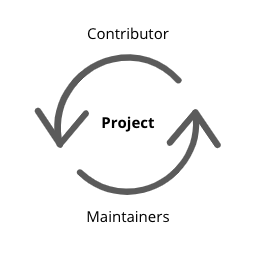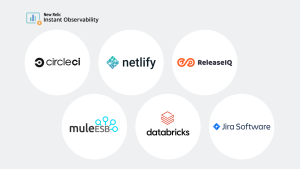Whether you're asking people to commit cash to your cause or code to your project, the lessons from open source and charitable giving can impact the way you approach and implement contributor programs. These lessons will also influence how you build and lead a community of contributors to scale and sustain your mission.
As a former nonprofit CTO and a New Relic customer, I now lead open source at New Relic, advocating for developers and building a community of open source maintainers who are building applications, integrations, and tools on the New Relic One platform.

So, what do nonprofits and the open source community have to teach one another about building contributor-centric systems? Read on for a few takeaways about how contribution is the engine that propels both open source projects and nonprofit organizations.
What is a contributor-centric system?
A contributor-centric system includes technology and related processes built to support and align people in a sustained relationship with an organization that champions a mission. The resulting system enables a virtuous cycle of mutual service to a common cause.
Contributors don’t give to the cause. They are a part of it.

Nonprofit experience
In 2009, I started working at CURE International, becoming the first technologist at the charitable international relief organization that builds and operates surgical centers in developing world settings.
During my CURE International tenure, we experienced a massive transformation at what was then a 12-year-old organization. As we were addressing things like which country to build a hospital in next, there was no way to tell donors—whether they gave $50 or $50,000—who they were helping. We wanted to help donors get involved with the full-person care the organization provided.
The internet made it possible to drop the distance between these two groups—the donors and folks getting care. We created a platform to tell the stories of people we were serving, in real time, and we invited people to engage with these stories. In nonprofits, a contributor-centric platform like this moves the charitable conversation from what you (as the nonprofit) do that the donor supports to what you (as the community surrounding this cause) do to serve the mission together through your time, attention, and resources.

Moving from paper records to open source software
While at CURE International, one challenge the organization faced was a lack of electronic health records (EHR). Often, patients lived 300 km from healthcare providers, making long-term patient follow-up difficult.

We needed to replace paper records to get information to the field efficiently, and we needed a solution that leveraged what cloud technology could offer, even when the internet wasn’t reliable. So a small team of software engineers built a modern, cloud-based healthcare information system (HIS).
At the time, there were other open source medical records systems, but not maintainer-friendly options, so we open-sourced our solution, HospitalRun. We engaged contributors from across the world by focusing on the developer experience of HospitalRun and inviting engineers to join us in advancing a free EHR/HIS software built specifically for developing world healthcare.
Building a contributor-centric system
As I reflect on my time at CURE International, I’ve developed a few principles that you might consider when creating a mission-aligned experience that invites contribution:
- Remember who you’re serving and why. Even though you’re building a system to support secondary customers (i.e., contributors), you need to keep your core mission at the forefront of your system.
- Communicate the mission clearly. I have found that conviction in the mission invites contribution. Perhaps counter-intuitively, casting the broadest net possible is unproductive when it comes to contributor engagement. Clarity of purpose demonstrates leadership in what it’s for and who it’s for.
- Create norms with options. It might seem unintuitive, but contributors want to be told what to do and what normative behavior looks like in your community. People also want to make their own calls about how they engage once they know what most community members do. Both norms and options are needed.
- Contributor engagement is a primary requirement. Contributor Experience is your key feature. Bake a sense of openness and welcome to the mission into any portion of the user experience possible. By treating every interaction as an opportunity to invite contributors, you increase the chance to find self-identified others and build community.
- Make experiences personal. Technology that enhances human connection is the goal. We’re not out to replace our work’s personal nature with software but to shrink the gap between the contributor and the impact. Technology enables the key to contributor engagement: person-to-person interaction.
- The relationship is the incentive. Recognition and rewards are useful, but they need to focus on tribal identity. Building a contributor community requires a higher order incentive than material prizes. Offering a sense of belonging to and a voice in the mission is the sticky incentive for a contributor-centric system. Conversely, transactional relationships center on the value of the goods exchanged.
Next steps
Here are three questions to ask and answer on the journey to creating a contributor-centric system.
- Are you communicating an opportunity that invites engagement?
- What technology platform can you build/implement to invite contributors to grow in their direct participation in your mission?
- How can you use technology to enhance your person-to-person engagement?
I hope we can all get smarter through dialog. Connect with me @tangollama.
Les opinions exprimées sur ce blog sont celles de l'auteur et ne reflètent pas nécessairement celles de New Relic. Toutes les solutions proposées par l'auteur sont spécifiques à l'environnement et ne font pas partie des solutions commerciales ou du support proposés par New Relic. Veuillez nous rejoindre exclusivement sur l'Explorers Hub (discuss.newrelic.com) pour toute question et assistance concernant cet article de blog. Ce blog peut contenir des liens vers du contenu de sites tiers. En fournissant de tels liens, New Relic n'adopte, ne garantit, n'approuve ou n'approuve pas les informations, vues ou produits disponibles sur ces sites.



